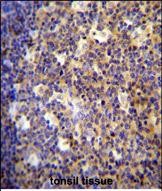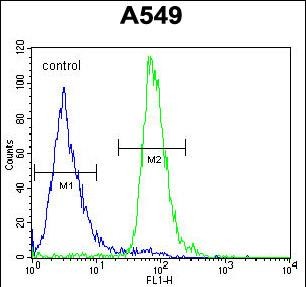ALOX12B Antibody (C-term)
Affinity Purified Rabbit Polyclonal Antibody (Pab)
- SPECIFICATION
- CITATIONS: 1
- PROTOCOLS
- BACKGROUND

Application
| WB, FC, IHC-P, E |
|---|---|
| Primary Accession | O75342 |
| Other Accession | Q2KMM4, O70582, NP_001130.1 |
| Reactivity | Human |
| Predicted | Mouse, Rat |
| Host | Rabbit |
| Clonality | Polyclonal |
| Isotype | Rabbit IgG |
| Calculated MW | 80356 Da |
| Antigen Region | 622-652 aa |
| Gene ID | 242 |
|---|---|
| Other Names | Arachidonate 12-lipoxygenase, 12R-type, 12R-LOX, 12R-lipoxygenase, 11311-, Epidermis-type lipoxygenase 12, ALOX12B |
| Target/Specificity | This ALOX12B antibody is generated from rabbits immunized with a KLH conjugated synthetic peptide between 622-652 amino acids from the C-terminal region of human ALOX12B. |
| Dilution | WB~~1:1000 FC~~1:10~50 IHC-P~~1:50~100 E~~Use at an assay dependent concentration. |
| Format | Purified polyclonal antibody supplied in PBS with 0.09% (W/V) sodium azide. This antibody is purified through a protein A column, followed by peptide affinity purification. |
| Storage | Maintain refrigerated at 2-8°C for up to 2 weeks. For long term storage store at -20°C in small aliquots to prevent freeze-thaw cycles. |
| Precautions | ALOX12B Antibody (C-term) is for research use only and not for use in diagnostic or therapeutic procedures. |
| Name | ALOX12B (HGNC:430) |
|---|---|
| Function | Catalyzes the regio and stereo-specific incorporation of a single molecule of dioxygen into free and esterified polyunsaturated fatty acids generating lipid hydroperoxides that can be further reduced to the corresponding hydroxy species (PubMed:21558561, PubMed:9618483, PubMed:9837935). In the skin, acts upstream of ALOXE3 on the lineolate moiety of esterified omega-hydroxyacyl-sphingosine (EOS) ceramides to produce an epoxy-ketone derivative, a crucial step in the conjugation of omega-hydroxyceramide to membrane proteins (PubMed:21558561). Therefore plays a crucial role in the synthesis of corneocytes lipid envelope and the establishment of the skin barrier to water loss (PubMed:21558561). May also play a role in the regulation of the expression of airway mucins (PubMed:22441738). |
| Cellular Location | Cytoplasm {ECO:0000255|PROSITE-ProRule:PRU00726}. Cytoplasm, perinuclear region |
| Tissue Location | Expressed in B-cells, hair follicles, foreskin keratinocytes and adult skin. Also expressed in psoriatic tissue |

Provided below are standard protocols that you may find useful for product applications.
Background
This gene encodes an enzyme involved in the converstion of arachidonic acid to 12R-hydroxyeicosatetraenoic acid. Mutations in this gene are associated with nonbullous congenital ichthyosiform erythroderma.
References
Han, S., et al. Hum. Immunol. 71(7):727-730(2010)
Rajaraman, P., et al. Cancer Epidemiol. Biomarkers Prev. 19(5):1356-1361(2010)
Vahlquist, A., et al. J. Invest. Dermatol. 130(2):438-443(2010)
Agarwal, S., et al. Exp. Dermatol. 18(11):939-946(2009)
Rajaraman, P., et al. Cancer Epidemiol. Biomarkers Prev. 18(5):1651-1658(2009)
If you have used an Abcepta product and would like to share how it has performed, please click on the "Submit Review" button and provide the requested information. Our staff will examine and post your review and contact you if needed.
If you have any additional inquiries please email technical services at tech@abcepta.com.














 Foundational characteristics of cancer include proliferation, angiogenesis, migration, evasion of apoptosis, and cellular immortality. Find key markers for these cellular processes and antibodies to detect them.
Foundational characteristics of cancer include proliferation, angiogenesis, migration, evasion of apoptosis, and cellular immortality. Find key markers for these cellular processes and antibodies to detect them. The SUMOplot™ Analysis Program predicts and scores sumoylation sites in your protein. SUMOylation is a post-translational modification involved in various cellular processes, such as nuclear-cytosolic transport, transcriptional regulation, apoptosis, protein stability, response to stress, and progression through the cell cycle.
The SUMOplot™ Analysis Program predicts and scores sumoylation sites in your protein. SUMOylation is a post-translational modification involved in various cellular processes, such as nuclear-cytosolic transport, transcriptional regulation, apoptosis, protein stability, response to stress, and progression through the cell cycle. The Autophagy Receptor Motif Plotter predicts and scores autophagy receptor binding sites in your protein. Identifying proteins connected to this pathway is critical to understanding the role of autophagy in physiological as well as pathological processes such as development, differentiation, neurodegenerative diseases, stress, infection, and cancer.
The Autophagy Receptor Motif Plotter predicts and scores autophagy receptor binding sites in your protein. Identifying proteins connected to this pathway is critical to understanding the role of autophagy in physiological as well as pathological processes such as development, differentiation, neurodegenerative diseases, stress, infection, and cancer.



